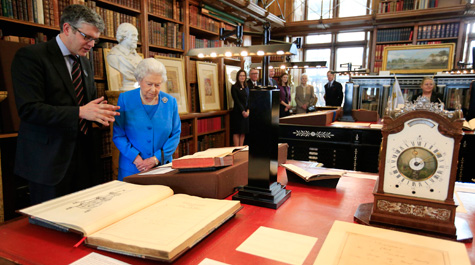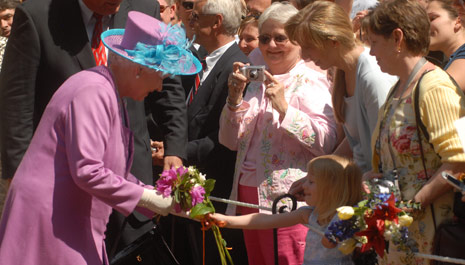First batch of royal Georgian papers released
William & Mary, Omohundro Institute are primary U.S. partners on colossal digitization project
For researchers, the nearly half-million royal documents housed in Windsor Castle’s iconic Round Tower aren’t quite the Holy Grail of archives, but they aren’t far off.
The first phase of the Georgian Papers Programme – roughly 33,000 digitized documents, including some penned by King George III regarding the American Revolution – will be publicly released and accessible at no cost beginning Saturday, Jan. 28.
The program represents a partnership between, on the American side, the Omohundro Institute of Early American History & Culture and William & Mary, with leading British partners the Royal Archives, Royal Library and King’s College London.
In America, the Georgian Papers website is georgianpapers-us.wm.edu, which also features more information about the project, related research, news, events and fellowship opportunities.
The goal is to digitize and release by 2020 the more than 350,000 documents related to Kings George I, II, III, IV, William IV and other members of the royal family, along with politicians, courtiers and others. Only 15 percent of the papers, spanning 1714 to 1837, have been previously published, mostly in editions.
 The project was launched in April 2015 by Queen Elizabeth II, who has twice visited William & Mary – once in 1957 and again 50 years later for the 400th commemoration of the founding of Jamestown.
The project was launched in April 2015 by Queen Elizabeth II, who has twice visited William & Mary – once in 1957 and again 50 years later for the 400th commemoration of the founding of Jamestown.
“Her Majesty fully supports the work currently underway to make the historic treasures of the Royal Archives widely accessible to the world through digital technology,” said Royal Librarian Oliver Urquhart Irvine. “Having the Omohundro Institute and William & Mary as our primary U.S. partners as the program develops is essential in bringing academic rigor, depth and context to the interpretation of key papers that will shed new light on the emergence of the United States of America itself.”
Mystery in the Round Tower
To recognize the significance of the Georgian Papers Programme, it’s helpful to understand the choreography of researchers who want to view primary documents in archives and special collections worldwide, explained Karin Wulf, W&M history professor and director of the Omohundro Institute.
Researchers begin by finding the relevant documents they’d like to view listed in the online catalog for the archives or the special collection. They register at the archive, placing their personal belongings in lockers before entering a supervised reading room. Because of security concerns, researchers are often allowed only to bring in a laptop computer and cell phone to photograph documents.
“So that’s what it’s like to work in a typical reader-access-oriented special collection or archival library. Now, Windsor Castle and the Royal Archives are nothing like that,” Wulf said.
 “The original goal was to preserve the material of the royal family,” she explained. “Their goal was a little like whatever you do with your grandmother’s letters – except their grandmother and great-grandfather just happen to be monarchs. It’s really this private archive, just of the royal family.”
“The original goal was to preserve the material of the royal family,” she explained. “Their goal was a little like whatever you do with your grandmother’s letters – except their grandmother and great-grandfather just happen to be monarchs. It’s really this private archive, just of the royal family.”
As such, the materials have not been fully cataloged, so over the years researchers and authors made educated guesses at what was in the Round Tower and then wrote to the queen’s private secretary for permission to view materials. Logistically, the Round Tower is not set up for reader services.
“All of this means that there were a very limited number of people they really could accommodate,” Wulf said.
Now, the digitization part of the Georgian Papers Programme will have each document scanned and photographed to create a high-resolution image, transcribed and tagged with descriptions and metadata allowing researchers to not only search the archive but to study and recombine it in new ways – “the kind of new digital humanities work that you can’t do with a paper edition,” Wulf said.
Historians have some expectations about what is included in the collection based on known correspondence, global affairs and what has already been published. And Wulf noted there are certain documents that could only be housed in the Round Tower.
“Scholars are really salivating as this has come to light and more and more people have learned that there are treasure troves of documents to go through,” said Stephen Hanson, W&M vice provost for international affairs and director of the Reves Center for International Studies.
Indeed, the project and some of its findings are the subject of a BBC Two documentary, “George III: The Genius of the Mad King,” released this month.
The program promises to deepen historians’ understanding about Britain’s role in the world, including its relationships with Colonial America, the fledgling United States and other European countries. Scholars also expect insights into British politics, the Enlightenment, science, food, artistic patronage, life at court, the education of royal children and more. The Royal Library is also augmenting the Georgian Papers with another 100,000 pages of its own manuscript material.
“We’re gratified that King’s College said that the Omohundro Institute are the people to work with and pleased that the Georgian Papers Programme recognized OI’s leadership in early American scholarship,” Wulf said.
Royal archive and colonial college
The roles of William & Mary and the Omohundro Institute are multi-pronged.
For the digitization project, the papers are being physically scanned in England, not exported overseas. But once a digital image is ready, students funded through W&M Libraries are working on transcribing the documents and tagging them with searchable and descriptive metadata. W&M Libraries staff members are also providing consultation for the project, working closely with the Omohundro Institute and the British partners on archival, technical and communications aspects of the project.
“This project provides a unique opportunity to work on an international digital project, setting standards for cataloging and digitization that will contribute to the ever-evolving role of libraries in the digital age,” said Carrie Cooper, W&M’s dean of university libraries. “The lessons we learn from this project will inform our work as we embark on digitizing, transcribing and making discoverable unique items in our own collections like the James Monroe Papers, diaries from the Civil War and the Robert Gates Papers. Digitizing our original collections and making them accessible to scholars worldwide is crucial to advancing scholarship.”
The Omohundro Institute, recognized globally as the leader in early American historical studies, is deeply embedded in the program. With funding through its Lapidus Initiative, it has committed to support up to eight research fellowships annually. The first were funded in 2015, along with additional fellowship paid for through King’s College London.
As the research fellows rotate through Windsor Castle’s Round Tower, they help to illuminate what’s in the archive for historians coming behind them. They will also document their findings on the American and British Georgian Papers portals in detailed blog posts.
 In 2015, Omohundro Institute-sponsored fellows researched authors of African descent at the Georgian Court and the imperial politics of Scottish emigration to revolutionary America.
In 2015, Omohundro Institute-sponsored fellows researched authors of African descent at the Georgian Court and the imperial politics of Scottish emigration to revolutionary America.
Last year, they delved into the early years of the Revolutionary War, the political and colonial schemes of Lord Bute (King George III’s closest adviser), the patron-client relationship between first minister Lord North and King George III, and European geopolitics and British foreign policy in pre-Revolutionary America.
“Included in the essays written by King George III are subjects like architecture, military tactics, constitution, all topics,” said Nick Popper, associate professor of history at William & Mary and member of the Omohundro Institute’s Council. “There will be something like 300 essays as part of the initial release, partly because they are among the most appealing sources [of future dissertations and books] that are going to emerge from this.”
In addition to the digitization and fellowships, the project also includes annual conferences, symposia and other events on both sides of the Atlantic. Already the project has promoted a fair bit of intercontinental travel, with faculty and staff from the Omohundro Institute and William & Mary’s Reves Center and Libraries visiting London and Windsor and personnel from the Royal Archives and King’s College London visiting W&M and Washington, D.C.
Next year, the Reves Center is funding a research trip, led by Popper, taking a number of W&M history students to London and the Round Tower. Other history professors are also integrating the Georgian Papers material into their classes at William & Mary this spring.
When the project initially launched, in 2015, it did so with a special event at Windsor Castle that had Queen Elizabeth II viewing documents from the archive. Both Hanson and Wulf were in attendance. At the launch, Wulf told the queen that, as an 18th-century scholar, she was ecstatic to be part of a project presenting the Round Tower’s holdings to the world.
“Having an opportunity to see the Georgian materials in the Round Tower was an extraordinary experience. I told her I levitated with excitement and that they had to drag me out,” Wulf said. “She laughed and asked if the Omohundro Institute is on the actual William & Mary campus.
“I said of course it is.”

























